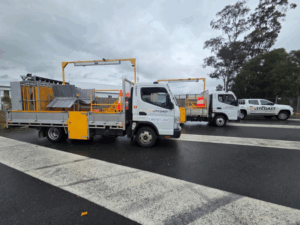Traffic control has come a long way from the simple stop-slow signs we often associate with roadworks. In today’s world, managing traffic involves a combination of cutting-edge technology, advanced planning, and skilled professionals who work together to ensure safety and efficiency. For East Coast Traffic Control (ECTC), complex infrastructure projects demand innovative approaches that go beyond basic traffic control measures, ensuring the smooth flow of vehicles while maintaining the highest safety standards.
Why Complex Projects Require Innovative Traffic Solutions
Large-scale infrastructure projects, such as highway upgrades, bridge constructions, and urban redevelopments, present unique challenges. These projects often take place in high-traffic areas, requiring sophisticated strategies to minimise disruptions, maintain access for local communities, and ensure the safety of workers and road users. As projects become more complex, the need for innovative traffic solutions grows.
The Limitations of Traditional Traffic Control Methods
While traditional traffic control methods like stop-slow signs, barriers, and cones are still essential, they are not always sufficient for complex projects. These methods are generally designed for straightforward tasks, such as temporary roadworks or minor repairs. However, larger projects with multiple stages, varying traffic conditions, and increased safety risks require a more sophisticated approach.
Technological Innovations in Traffic Management
One of the key ways ECTC addresses complex traffic management challenges is through the integration of advanced technologies. Here are some innovative solutions currently used in traffic control:
1. Intelligent Traffic Management Systems (ITMS)
ITMS use real-time data to monitor traffic conditions and make adjustments to traffic control strategies. These systems can automatically change traffic light sequences, reroute vehicles, and even control electronic message signs based on live traffic conditions. For example, during peak hours or emergencies, ITMS can prioritise certain routes or vehicles, such as emergency services, to ensure they reach their destinations quickly.
2. Automated Traffic Monitoring and Surveillance
Drones, cameras, and sensors can be used to monitor traffic in real-time, providing valuable data on vehicle flow, congestion, and potential hazards. This information helps traffic controllers make informed decisions quickly, reducing the risk of accidents and improving traffic flow. Drones can also be used to survey large areas, offering a bird’s-eye view that is particularly useful for complex projects like highway construction or bridge repairs.
3. Variable Message Signs (VMS)
Variable message signs are electronic signs that can be updated in real-time to provide important information to drivers. These signs are used to inform road users about changes in traffic conditions, detours, speed limits, or safety warnings. In complex projects, VMS plays a critical role in guiding motorists through unfamiliar routes and adjusting traffic flow as work progresses.
4. Temporary Traffic Management Apps
Apps designed for temporary traffic management allow project managers to communicate directly with drivers, providing updates on road conditions, closures, and alternative routes. These apps can be used in conjunction with other traffic management tools to provide a seamless traffic control experience for road users.
Advanced Planning and Modelling Techniques
Successful traffic control for complex projects requires more than just technology; it also involves detailed planning and modelling. ECTC uses advanced planning techniques to ensure that all potential scenarios are considered before work begins.
1. Traffic Impact Assessments (TIA)
TIA involves assessing the potential impact of a project on traffic patterns, road safety, and local communities. By understanding these impacts in advance, traffic control plans can be tailored to minimise disruptions and ensure that the project runs smoothly.
2. Traffic Flow Modelling
Using sophisticated software, ECTC models different traffic flow scenarios to identify potential bottlenecks and develop solutions to mitigate them. This modelling takes into account factors such as peak traffic times, road capacity, and alternative routes, ensuring that the traffic management plan is as efficient as possible.
The Importance of Skilled Professionals
Even with the latest technology and detailed planning, the success of complex traffic management projects ultimately comes down to the skills and expertise of the people on the ground. At ECTC, our traffic controllers, project managers, and support staff undergo rigorous training to handle a wide range of scenarios.
1. Comprehensive Training Programs
ECTC’s training programs cover everything from basic traffic control techniques to advanced skills for managing complex projects. This ensures that our teams are always prepared to respond to changing conditions and unforeseen challenges.
2. On-the-Ground Adaptability
Our teams are trained to adapt quickly to evolving situations, such as sudden weather changes or unexpected traffic conditions. This adaptability is essential for ensuring safety and minimising disruptions, particularly in projects where conditions can change rapidly.
Addressing Safety Challenges in Complex Projects
Safety is a top priority for ECTC, especially in large-scale projects where risks are higher. Our innovative traffic solutions are designed not only to improve traffic flow but also to protect workers and road users.
1. Temporary Barriers and Crash Attenuators
For high-risk areas, temporary barriers and crash attenuators are used to protect both workers and motorists. These devices absorb the impact of a collision, reducing the severity of an accident and preventing vehicles from entering work zones.
2. Enhanced Worker Safety Protocols
Safety protocols for workers include wearing high-visibility clothing, setting up designated safe zones, and using safety barriers to separate workers from traffic. ECTC ensures that these protocols are strictly followed on all job sites.
Future Trends in Traffic Management
As infrastructure projects continue to grow in scale and complexity, traffic management will need to keep pace with new challenges. Emerging trends include the use of artificial intelligence for predictive traffic modelling, autonomous traffic control devices, and greater integration of traffic management systems with smart city technologies.
Final Word: The Future of Traffic Control Is Here
Complex infrastructure projects demand innovative traffic management solutions that go beyond traditional methods. At ECTC, we combine technology, advanced planning, and skilled professionals to deliver traffic control services that meet the unique needs of each project. As we continue to push the boundaries of what’s possible, ECTC remains committed to providing the highest standards of safety and efficiency in traffic management.
FAQs
- What makes traffic control for complex projects different from standard roadworks?
Complex projects often involve multiple stages, higher traffic volumes, and greater risks, requiring advanced solutions beyond traditional stop-slow signs. - How does technology help improve traffic control for complex projects?
Technologies like ITMS, drones, and VMS allow for real-time monitoring, data analysis, and adaptive traffic control, enhancing safety and efficiency. - Why is advanced planning important for complex traffic management projects?
Advanced planning ensures that all potential scenarios are considered, allowing for a more efficient traffic management plan that minimises disruptions. - How does ECTC ensure the safety of workers during complex projects?
ECTC uses safety measures like temporary barriers, crash attenuators, and strict safety protocols to protect workers from traffic-related risks.
What are the future trends in traffic management for complex projects?
Future trends include AI for predictive modelling, autonomous traffic control devices, and integration with smart city technologies.





